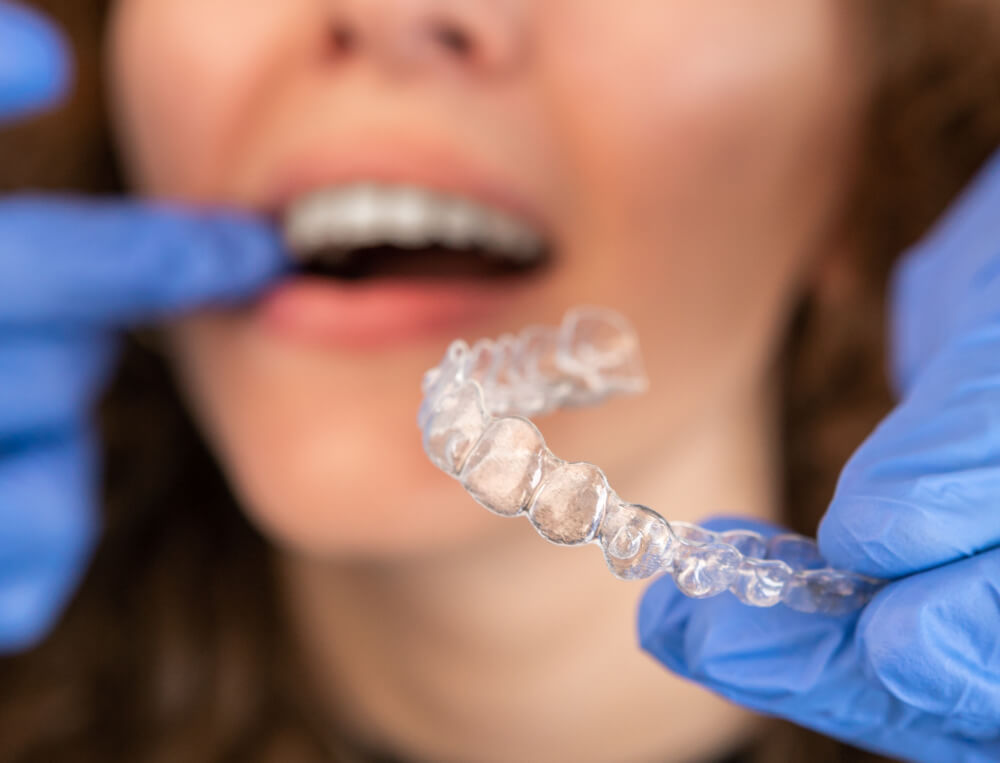Invisalign has revolutionized orthodontic treatment by offering a discreet and convenient way to straighten teeth. However, while many focus on the cosmetic benefits of Invisalign, it’s essential to consider its potential impact on gum health. Gum recession, a condition where the gum tissue pulls away from the teeth, exposing the roots, can have serious implications if left unchecked.
This article delves into the lesser-discussed topic of whether Invisalign can cause gum recession and what patients need to know to protect their oral health during treatment. Understanding these risks can help you make an informed decision about your orthodontic care.
Understanding Gum Recession
Gum recession occurs when the gum tissue that surrounds the teeth wears away or pulls back, exposing more of the tooth or its root. This condition is not just a cosmetic issue; it can lead to increased sensitivity, higher risk of decay, and even tooth loss if left untreated.
While gum recession is often associated with poor oral hygiene or aggressive brushing, it can also result from factors like genetics, periodontal disease, and even orthodontic treatments. What’s less commonly discussed is how the shifting of teeth during orthodontic treatment, like Invisalign, can influence gum positioning. As teeth move to their new positions, the pressure exerted by the aligners can sometimes cause the gums to retract, particularly if there is already underlying gum inflammation or bone loss.
Additionally, the continuous wear of aligners can lead to changes in the oral environment, such as altered saliva flow and bacterial accumulation, which may further contribute to gum issues if not properly managed. Understanding these dynamics is crucial for patients considering or undergoing Invisalign treatment, as it underscores the importance of vigilant oral care and regular dental checkups to prevent gum recession and other complications.
Invisalign and Its Impact on Gums
Invisalign is celebrated for its ability to straighten teeth discreetly, but its impact on gum health is a topic that deserves more attention. The relationship between Invisalign and gum health is complex and multifaceted, involving the way aligners interact with both the teeth and the surrounding soft tissues.
Can Invisalign Cause Gum Recession?
The concern that Invisalign might cause gum recession is rooted in how the aligners function. As Invisalign gradually shifts teeth into new positions, the forces exerted by the aligners can sometimes place pressure on the gums. This pressure can be particularly problematic for patients who already have thin or receding gums, as it may exacerbate the condition. Additionally, if the aligners do not fit perfectly or if they are worn incorrectly, they can irritate the gums, potentially leading to inflammation and recession over time. It’s crucial for patients to monitor their gum health closely during treatment and report any changes to their dentist immediately.
Invisalign Side Effects on Gums
Beyond the risk of gum recession, there are other potential side effects on gums that can occur during Invisalign treatment. One of the lesser-known issues is the potential for localized gum inflammation, often caused by the aligners trapping bacteria and plaque against the gumline. Unlike traditional braces, which can be cleaned more thoroughly around the brackets and wires, Invisalign aligners can create pockets where bacteria thrive if not cleaned properly. This buildup can lead to gingivitis, an early stage of gum disease, which if left untreated, can progress to periodontitis—a more severe condition that can result in gum recession and bone loss.
Another aspect that is seldom discussed is how the continuous pressure applied by Invisalign might alter the blood flow to the gums. This can potentially slow down the healing of any minor gum injuries, making it easier for recession to develop. Moreover, the frequent removal and reinsertion of aligners can sometimes cause microtrauma to the gums, particularly if the aligners are not handled gently.
Patients need to be aware of these potential side effects and take proactive steps to mitigate risks. This includes maintaining rigorous oral hygiene, ensuring proper fit and usage of the aligners, and keeping regular dental appointments to monitor gum health throughout the Invisalign process.
Preventing Gum Recession During Invisalign Treatment
Maintaining gum health during Invisalign treatment requires proactive measures to prevent gum recession and other complications. While Invisalign is generally safe and effective, understanding how to minimize risks to your gums is crucial for a successful treatment outcome.
Importance of Oral Hygiene
The first and most critical step in preventing gum recession during Invisalign treatment is maintaining excellent oral hygiene. Unlike traditional braces, Invisalign aligners are removable, which means it’s easier to brush and floss effectively. However, the aligners can trap food particles and bacteria against the teeth and gums if not cleaned properly. Patients should brush their teeth after every meal before reinserting the aligners to prevent plaque buildup. Flossing daily is also essential to remove food particles and plaque from between the teeth and under the gumline, areas that are particularly vulnerable to gum disease.
In addition to brushing and flossing, it’s recommended to use an antimicrobial mouthwash to reduce bacterial load and protect the gums. Regular cleaning of the aligners themselves is also important. This can be done using a soft toothbrush and clear antibacterial soap, ensuring no food particles or bacteria are transferred back into the mouth.
Regular Dental Checkups
Routine dental visits are indispensable during Invisalign treatment. Regular checkups allow your dentist to monitor the health of your gums and catch any early signs of gum recession or inflammation. Early detection is key to preventing more severe gum issues that could derail your treatment. During these visits, your dentist can also clean areas that are difficult to reach with regular brushing and flossing, further reducing the risk of gum problems.
Moreover, your dentist can assess the fit of your aligners. Aligners that don’t fit properly can exert uneven pressure on the teeth and gums, potentially leading to gum recession. Adjustments can be made to ensure that your aligners are working effectively without compromising your gum health.
Proper Fit and Use of Aligners
Ensuring that your aligners fit correctly is vital for both the effectiveness of the treatment and the health of your gums. Aligners that are too tight or improperly positioned can cause excessive pressure on the gums, leading to irritation and potentially contributing to recession. It’s important to follow your dentist’s instructions regarding how long to wear the aligners each day—typically 20 to 22 hours—and to avoid unnecessary removal and reinsertion, which can irritate the gums.
If you notice any discomfort or if the aligners seem to be irritating your gums, it’s crucial to consult your dentist immediately. They can make the necessary adjustments to prevent any long-term damage to your gums. By taking these steps, you can significantly reduce the risk of gum recession and ensure that your Invisalign treatment progresses smoothly.
What to Do If You Experience Gum Recession During Invisalign
Identifying Signs of Gum Recession
Gum recession can manifest subtly at first. You might notice that your teeth appear longer, or you may feel increased sensitivity to hot or cold foods and drinks. In some cases, you might observe small notches near the gumline, which indicate exposed tooth roots. If you detect any of these signs, it’s important to contact your dentist as soon as possible.
Treatment Options
Once gum recession is identified, your dentist will assess the severity and determine the appropriate course of action. Treatment options may include:
- Scaling and Root Planing: A deep cleaning procedure that removes plaque and tartar from below the gumline, helping to reduce inflammation and prevent further recession.
- Gum Grafting: In more severe cases, a gum graft may be necessary to restore lost tissue and protect the exposed roots. This surgical procedure involves taking tissue from another part of your mouth and attaching it to the affected area.
- Adjustments to Invisalign Treatment: If the aligners are contributing to the recession, your dentist may recommend modifications to your treatment plan or adjustments to the aligners to reduce pressure on the gums.
Early intervention is key to managing gum recession effectively and ensuring the success of your Invisalign treatment.
Conclusion
While Invisalign is an effective and popular method for straightening teeth, it’s important to be mindful of potential impacts on gum health, including the risk of gum recession. With proper care, regular dental checkups, and attention to aligner fit, you can minimize these risks and enjoy a healthy, beautiful smile.
If you’re concerned about gum recession or want to explore Invisalign as an option, we’re here to help. Schedule an appointment with us today or call (202) 955-5787 to discuss your dental health needs and options.


